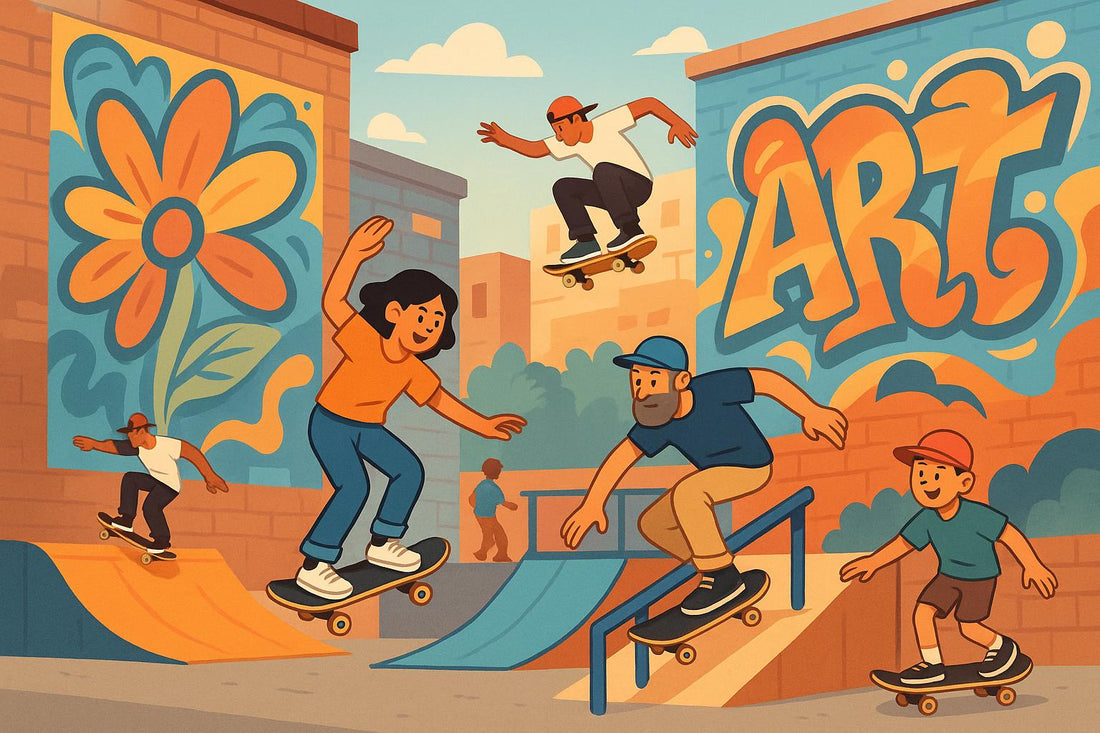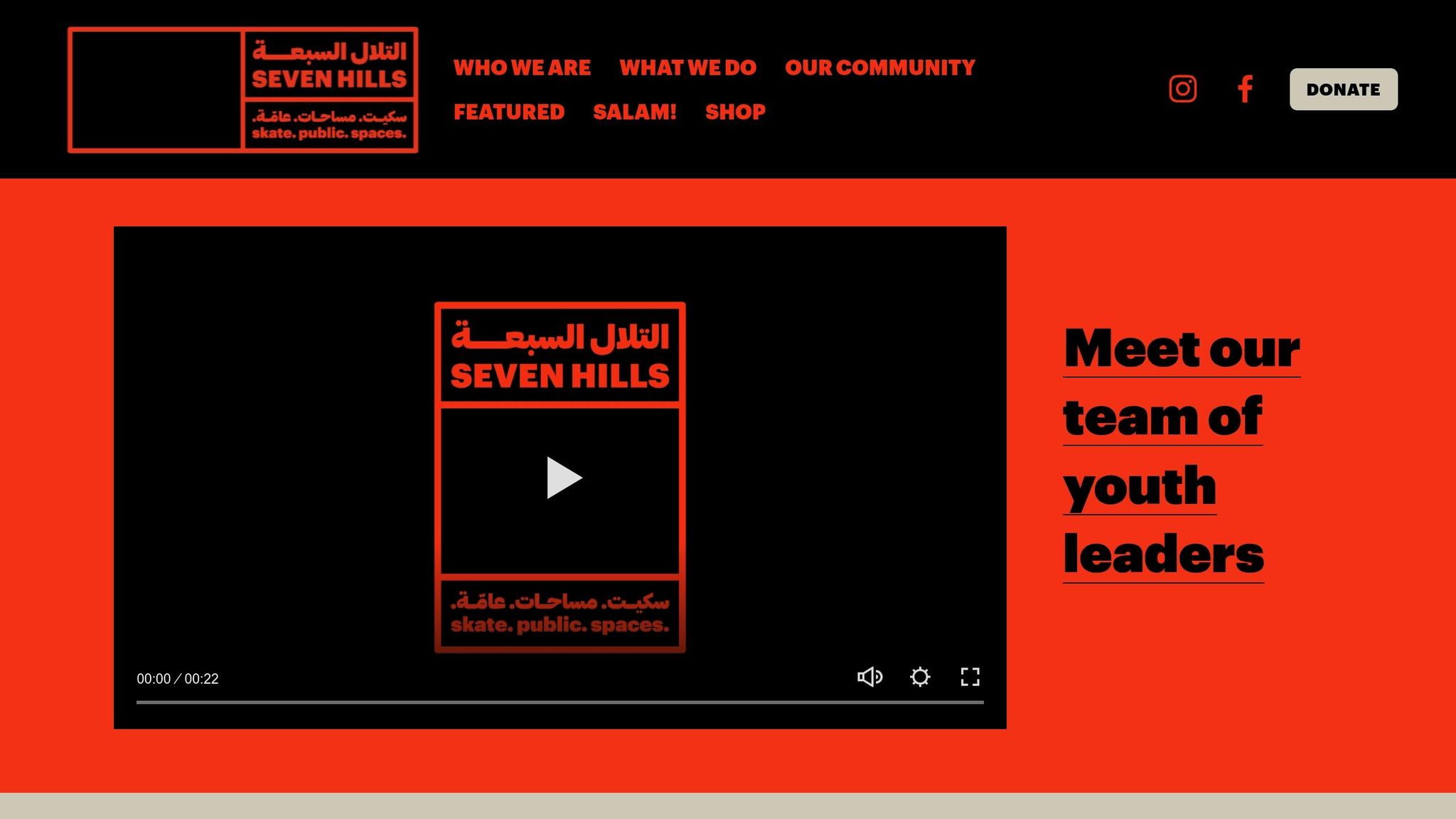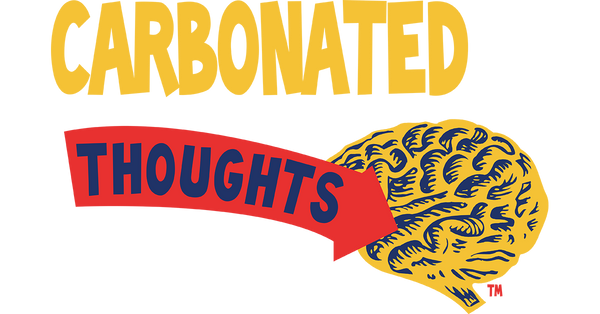
Skateboarding and Urban Art: A Community Connection
Share
Skateboarding and urban art aren’t just hobbies - they’re lifelines for self-expression and community building. These two movements started in the 1960s, born from economic challenges and generational struggles, and have since shaped cityscapes and youth culture worldwide.
- Skateboarding began in Southern California and evolved into a global phenomenon, reclaiming urban spaces and fostering inclusivity. It’s now a $3.2 billion industry with Olympic recognition.
- Urban art, rooted in graffiti from New York City, turns abandoned spaces into vibrant canvases, blending rebellion and creativity.
- Both embrace a DIY spirit, transforming neglected areas into community hubs that combine art, sport, and social connection.
Quick Facts:
- 60% of skateboarders also pursue creative arts.
- Skateparks and murals often coexist, merging sport and art.
- Challenges include safety concerns, commercialization, and legal issues for graffiti.
Together, skateboarding and urban art redefine public spaces, offering platforms for connection and creativity, while balancing the tension between mainstream acceptance and underground roots.
1. Skateboarding Culture
Origins and Evolution
In just over six decades, skateboarding has grown from a casual sidewalk activity to a global cultural movement. It all began in 1959 when Roller Derby introduced the first mass-produced skateboard. This marked the start of a shift in American urban life, turning skateboarding into a defining feature of modern culture.
By the 1970s, skaters started reclaiming urban spaces, transforming everyday environments into skateable terrain. This mindset was perfectly captured by legendary skater Natas Kaupas, who said:
"We look at an object and think of it completely differently than its intended purpose."
The 1980s and 1990s saw street skating flourish, blending seamlessly with punk rock and a DIY ethos. This era also gave rise to professional leagues and branded merchandise, turning skateboarding into a booming industry. By the 2000s, urban planners began to recognize the cultural and social value of skateboarding, a shift that culminated in its Olympic debut at the Tokyo 2020 Games. This journey has laid the foundation for vibrant, community-oriented spaces around the world.
Community Spaces
Skateboarding thrives in spaces that bring people together - skate shops, parks, and DIY spots all play a vital role. These places are more than just venues; they’re cultural hubs where creativity, skills, and community intersect. Skateparks, for instance, offer safe and accessible environments for both practice and social connection, while DIY skate spots embody the grassroots spirit of the skateboarding world. Many of these spaces also feature skatepark murals, blending skateboarding with urban art in a way that feels authentic and raw.
But skateboarding is about more than individual skill - it's about belonging. As The Supply Network explains:
"Skateboarding is a community-based activity that thrives on inclusivity, diversity, and mutual respect. The sense of belonging that comes from being a part of this community is something truly special and unique. Whether you're a seasoned pro or just starting out, there's always room for everyone in the skateboarding world."
This inclusive ethos has driven initiatives to create gender-inclusive spaces and programs for underprivileged youth. Platforms like Carbonated Thoughts celebrate this creative energy, combining skate culture with urban art through products and services that reflect the movement’s dynamic spirit.
Collaborations and Partnerships
The collaborative nature of skateboarding is evident in efforts like Rob Dyrdek’s Safe Spot Skate Spot Foundation, which he launched in 2007 to fund the construction of legal and safe skate plazas. Dyrdek summed up the changing perception of skateboarding with one simple statement:
"It's not a crime, it's a culture."
Skateboarding’s influence extends to architecture and urban planning as well. Urban planner Michael Ford notes:
"Today, integrating opportunities for skateboarding into a design has become a mark of thoughtful, innovative public space design."
These collaborations have redefined public spaces, often emphasizing sustainability. For example, some modern skateparks are built using recycled concrete or powered by renewable energy. Skateboarding brands are also stepping up, promoting LGBTQ+ inclusion and supporting racial justice movements through marketing and social media.
Challenges and Controversies
Despite its mainstream success, skateboarding still faces hurdles. It’s often viewed as disruptive, partly due to concerns about property damage and safety. Urban planners struggle to balance integrating skateboarding into public spaces with the needs of other users. High injury rates among young skaters further fuel safety debates. At the same time, skateboarding grapples with maintaining its underground authenticity while becoming increasingly commercialized. Like graffiti, skateboarding exists in a space where it’s both celebrated and criminalized.
Professor Shane Blackman captures this tension:
"The deviant subcultural images of skateboarding derived from dirty and dark urban spaces only given colour and light by Graffiti artists, the perception of damage to property and risk-taking in public places saw it as a near criminal activity with 'attractive stunts.'"
Yet, skaters have proven they can fight for their spaces. In London, for instance, skaters successfully protested redevelopment plans to preserve the iconic Southbank Skatepark. As Associate Professor Åsa Bäckström observes:
"Skateboarding has evolved from a creative urban activity with a legendary past meshed with subcultural values into an Olympic sport and a platform for multinational industry and global enterprises."
This evolution underscores how skateboarding and urban art continue to shape and redefine spaces for community expression.
2. Urban Art Community
Origins and Evolution
Urban art, much like skateboarding, has its roots in youth culture - a culture that thrives on rebellion and self-expression in cityscapes. These two worlds naturally intersect, turning urban spaces into dynamic canvases for creativity and individuality. Over time, this connection has grown stronger, with skateboarding and urban art influencing and inspiring each other.
As lifelong skateboarder Bob Bass puts it:
"Skateboarding culture (BMX, Inline Skating and Scooter Riding etc.) has always gone hand in hand with graffiti as an accepted form of expression, rebellion, and art. It's a culture thing, and that's probably the best answer you are going to get on that topic because it's the only logical explanation."
This synergy became more pronounced over the years. Skateboard graphics evolved into more artistic designs, and skateparks often turned into showcases for graffiti art. Collaborations between skaters and artists blurred the boundaries between sport and art, creating a shared space for expression. A notable example of this creative blend is artist Jules Magistry’s reimagining of skate imagery in 2016. After Brian Anderson, Thrasher’s 1991 Skater of the Year, publicly came out as gay, Magistry re-illustrated Anderson's photos, exploring themes of aggression and identity. These shared values have fostered urban art spaces that not only celebrate creativity but also strengthen community bonds.
Community Spaces
Urban art and skateboarding have given rise to community spaces that double as hubs for creativity and connection. Take the Humboldt Avenue Skate Park in Chico, California, for instance. It features designated areas specifically for urban art, with murals regularly refreshed by local artists. The district announced:
"We are officially announcing Phase 1 of the Urban art zones at the park! Artists can create using the north, south and west (back and sides) of the building INSIDE the park... We simply ask that artist keep their art rated PG (No vulgarity or obscenity.)"
In Atlanta, Village Skate Park ATL transformed an abandoned warehouse into a vibrant community center. It offers not just skateboarding but also youth programs and creative workshops. Velnice Aart, representing the park, highlights their approach:
"I think that we stand out in terms of the sense of community that we bring and the sense of care. Often, skate parks are public parks where there's not usually someone there who cares... But we like to be inclusive and sort of reach out and help those that we see needing help."
San Francisco’s U.N. Plaza saw a dramatic transformation after a $2 million renovation in 2023 introduced a 13,000-square-foot skate plaza. The changes led to a 64% drop in daytime drug-related incidents and a 5% increase in daily visitors. The revamped plaza also includes exercise stations, ping pong tables, and chess tables alongside the skateboarding facilities.
Collaborations and Partnerships
Partnerships between artists, brands, and city officials are reshaping how urban art integrates into public spaces. At Place de la République in Paris, for example, Volcom, a skate and surf apparel brand, teamed up with artist Paolo Guidi and local authorities to create a permanent skate structure during the plaza’s redevelopment in the 2010s. Guidi explained:
"Skateboarding always had a bad image, and politicians usually see skaters as invaders, but most are very respectful... We used skateboarding to show that you can think about public spaces differently. I wanted to show what's underneath that. Skating is beautiful and pure."
Today, the plaza hosts skateboarding competitions, photography exhibitions, film screenings, and even live DJ sets, making it a hub for diverse communities. Skate brands also frequently collaborate with street artists to design decks, clothing, and accessories. These projects highlight how creative partnerships can transform urban spaces into thriving cultural centers.
Institutional support is also playing a key role. The Atlanta Regional Commission, for example, emphasizes collaboration with local communities. As Roshani Thakore noted:
"The goal is to co-design with the community, and we're committed to making that happen."
Challenges and Controversies
Despite its growing acceptance, the urban art community still faces hurdles. Graffiti is often labeled as vandalism, leading to legal challenges and a tarnished reputation. Women in these spaces frequently encounter bias and discrimination. Additionally, graffiti is sometimes linked with unsafe or neglected areas, further complicating its perception.
Advocates, however, continue to work toward greater understanding and acceptance. Bob Bass, reflecting on the relationship between skateparks and graffiti, shared:
"If I were to open a skatepark, I'd expect it to be tagged. As long as it wasn't gang graffiti, I wouldn't mind it. I wouldn't even call it vandalism. My target demographic would be the same people doin..."
Interestingly, many skateparks now incorporate graffiti into their initial designs, blending art into the environment from the start. Social media and online platforms are also helping to bridge the gap, showcasing the natural connection between skateboarding and graffiti to a wider audience.
Grey Spaces, Public Planning Places and Urban Play: Skate, Create, Educate
sbb-itb-e116ef9
Pros and Cons
The dynamic relationship between skateboarding and urban art continues to shape community identities, offering benefits while facing certain challenges. These two cultural movements complement each other in many ways, but their growth and integration into communities come with complexities. Below is a comparison of their impacts:
| Aspect | Skateboarding Benefits | Urban Art Benefits | Skateboarding Challenges | Urban Art Challenges |
|---|---|---|---|---|
| Community Impact | Revitalizes areas in need of attention. | Transforms public spaces into vibrant, creative hubs that reflect local culture. | Often clashes with institutional rules, leading to resistance from authorities. | Struggles with inclusivity and representation can limit participation. |
| Health & Wellness | Boosts physical fitness, including cardiovascular health, balance, and coordination, while supporting mental well-being. Reduces stress and fosters a sense of accomplishment. | Promotes mental health through creative expression and community connections. | High risk of injuries, particularly for beginners. | Focuses more on creativity and mental health, offering little in terms of physical activity. |
| Social Development | Encourages social interaction, teamwork, and empathy. Notably, 65% of skaters under 18 have mentors over 21. | Provides platforms for creative collaboration and community engagement. | Faces barriers related to gender and socio-economic factors, limiting inclusivity. | Accessibility issues and lack of representation hinder broader participation. |
| Economic Impact | The global skateboarding market is projected to hit $3.2 billion by 2028, driving job creation and tourism. | Enhances neighborhoods, potentially spurring economic growth through revitalization. | Commercialization risks diluting the grassroots essence of skateboarding. | Legal and reputation challenges can restrict economic potential. |
| Inclusivity Efforts | Programs like Skateistan engage displaced and low-income communities, with 56% female participation globally. | Urban art projects aim to create inclusive spaces, though accessibility challenges persist. | Adult participation remains limited, even as youth engagement grows. | Barriers to full participation continue to affect many groups. |
Physical and Creative Benefits
Skateboarding offers more than just thrills - it builds strength, endurance, flexibility, and balance. Interestingly, about 60% of skateboarders are also involved in creative pursuits like music or painting, blending physical activity with artistic expression. This natural overlap strengthens the bond between skateboarding and the arts.
Documentation and Community Building
Skateboarders are avid documenters, with over 75% capturing their experiences through video and photography. This practice ties skateboarding to visual arts, fostering a sense of community and drawing in new participants. It’s a unique way of blending physical movement with storytelling.
Mainstream Adoption
Sweden provides a compelling example of how skateboarding can maintain its core values while gaining institutional support. Since 2013, the sport has been recognized under the National Sports Confederation, promoting "sports for all" with an emphasis on social inclusion. This demonstrates that commercialization doesn’t have to compromise authenticity when community values are prioritized.
A Case Study: Seven Hills

Organizations like Seven Hills showcase the impact of grassroots efforts. Co-founder Mohammed Zakaria highlights the diversity their programs have fostered:
"We see a diverse group in our sessions, local children from Jordan, playing alongside Palestinians, Syrians, and those from many other backgrounds we didn't even know were present in our country: Somali, Yemeni, Sudanese. This has resulted in a strong, ever-growing community."
However, Zakaria is candid about the challenges:
"Absence of challenges may indicate overlooked issues. There are always challenges, big ones, small ones, new ones, old ones. If you aren't experiencing these, you're either ignoring them or you're doing something ineffective. You want to be consistently learning, adapting, and moving forward."
For communities considering skateboarding and urban art initiatives, balancing the benefits against the challenges is crucial. With thoughtful strategies, inclusive programs, and active community involvement, these movements can create lasting positive impacts.
Conclusion
Community participation has reshaped urban life by merging skateboarding and urban art into a powerful cultural force. What began as underground subcultures has grown into influential movements that redefine urban identity. Both skateboarding and street art share a DIY ethos, challenging conventions and naturally complementing each other. Skate parks become vibrant canvases for graffiti, while street art captures the raw energy of skate culture, creating a dynamic relationship that continuously reinvents city narratives.
Globally, skateboarding is thriving, with 85 million regular participants and a projected market value of $3.2 billion by 2028 [9, 12]. But the impact goes beyond numbers. A striking 60% of skateboarders are involved in creative pursuits like music and visual arts, seamlessly blending physical movement with artistic expression.
Cities are starting to embrace this energy. Skateboarding communities are increasingly engaging with local governments, showing a readiness to collaborate on urban projects. Examples like Montreal's Vans Park and Kamloops' watermelon mural highlight how partnerships between skaters, artists, and city officials can transform public spaces into multifunctional hubs for recreation, art, and community. However, as these projects grow, ensuring inclusivity and maintaining community ownership remain critical.
The future of these movements lies in preserving diversity and empowering local voices. Douglas Miles of Apache Skateboards exemplifies this by using skateboarding and art to connect Native youth with their heritage, blending cultural preservation with fresh forms of expression.
Grassroots efforts continue to breathe life into neglected urban spaces. Local skaters and artists don’t just occupy these areas - they transform them. Through DIY skateparks and street art, they turn forgotten corners into thriving cultural centers. This hands-on approach guarantees authenticity and fosters lasting, positive change.
As cities increasingly view skateboarding and urban art as symbols of youth, creativity, and openness, these movements are becoming key to redefining urban spaces. For brands like Carbonated Thoughts, which combine skateboarding, streetwear, and creative services, this evolution offers not just opportunities but also a responsibility to champion grassroots creativity and expression.
FAQs
How do skateboarding and urban art bring communities together and encourage self-expression?
Skateboarding and urban art have a unique way of bringing people together while encouraging self-expression. Skateboarding fosters a sense of community by creating shared spaces where individuals can connect, learn from each other, and offer support. It’s not just about the tricks - it’s about the creativity and individuality that skaters showcase through their personal style and skills.
Urban art, meanwhile, turns public spaces into lively, visual stories that reflect the identity and pride of a community. Whether it’s a bold mural or intricate graffiti, these artworks celebrate diversity and often convey powerful messages that spark conversations and build connections. Together, skateboarding and urban art create vibrant communities where creativity and freedom flourish.
What obstacles do skateboarding and urban art face in becoming more accepted while staying true to their underground culture?
Skateboarding and urban art face an uphill battle against legal restrictions, public skepticism, and limited access to urban spaces. These hurdles can often lead to criminalization or exclusion, stifling the ability of these creative expressions to flourish in public areas.
At the same time, there's the tricky balance of gaining mainstream recognition while staying true to their raw, rebellious roots. Both skateboarding and urban art thrive on their underground culture, but finding ways to overcome legal and social barriers without compromising their identity is essential for their evolution and wider acceptance.
How do collaborations between skaters, artists, and city officials turn public spaces into thriving community hubs?
Collaborations between skaters, artists, and city officials have turned public spaces into lively community centers by blending skateboarding culture with urban art. These efforts often produce skateparks and art installations that not only mirror the character of local neighborhoods but also promote social connections and breathe new life into the surrounding areas.
Take the expanded UN Skate Plaza in San Francisco or Lot 11 Skatepark in Miami as examples. These spaces demonstrate how thoughtful planning and collaboration can result in places that are both practical and inviting. They showcase how skateboarding and art can unite communities, spark creativity, and transform urban landscapes into energetic, inclusive spaces for all.
